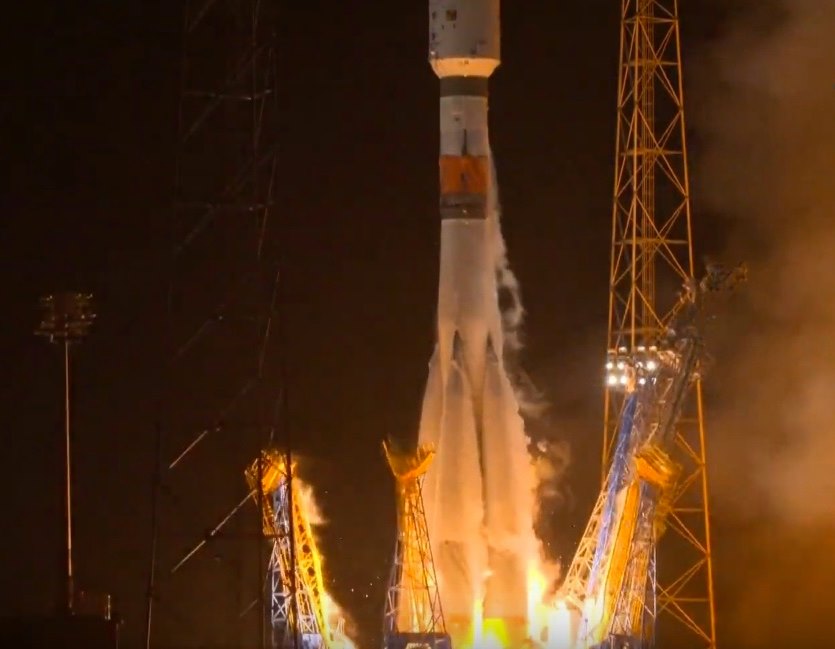Europe Launches CHEOPS Satellite to Study Alien Worlds
CHEOPS will characterize exoplanets around bright, nearby stars.
A new exoplanet mission took to the skies early this morning (Dec. 18), on a quest to better understand the metrics of distant worlds.
The European probe, called Characterizing Exoplanet Satellite (CHEOPS), lifted off atop a Soyuz rocket from Guiana Space Center in Kourou, French Guiana, at 3:54 a.m. EST (0854 GMT; 5:54 a.m. local time). The dazzling predawn event drew a flock of spectators.
The Soyuz successfully deployed CHEOPS into Earth orbit about 2.5 hours after liftoff, representatives of France-based launch provider Arianespace said.
Related: The Strangest Alien Planets (Gallery)
Several other satellites are riding on the rocket as well. All were deployed as planned by about 4 hours minutes after launch, making Arianespace's ninth and final mission of 2019 complete.

CHEOPS' main mission involves examining bright, relatively nearby stars that astronomers know have planets orbiting them. Watching known planets orbit their stars is important to better understand certain characteristics, such as how long their orbits are and how big the planets are. Astronomers are interested in learning about the habitability of distant worlds, which depends in part on if a planet is rocky (closer to Earth's size) or gaseous (closer in size to Uranus, Neptune, Saturn or Jupiter).
CHEOPS will "make high-precision observations of the planet's size as it passes in front of its host star," European Space Agency (ESA) officials wrote in a mission description. "It will focus on planets in the super-Earth to Neptune size range, with its data enabling the bulk density of the planets to be derived — a first-step characterization towards understanding these alien worlds."
Get the Space.com Newsletter
Breaking space news, the latest updates on rocket launches, skywatching events and more!
CHEOPS will do this via the "transit method," measuring how much a host star dims when a planet crosses its face from the probe's perspective. This is a tried and true exoplanet technique; it was also used by NASA's pioneering Kepler space telescope, for example, and is currently employed by the American space agency's Transiting Exoplanet Survey Satellite (TESS).
CHEOPS is a small-class mission; its price tag is about 50 million euros ($55.7 million at current exchange rates).
Four other satellites joined CHEOPS on its ride into space. They are:
- The COSMO-SkyMed Second Generation satellite, an imaging craft for the Italian Space Agency and Minister of Defence;
- ANGELS (Argos Neo on a Generic Economical and Light Satellite), for the French national space agency (CNES), which will study Earth's environment from orbit;
- EyeSat, a satellite for CNES. It will study astronomical phenomena such as our own Milky Way galaxy and the zodiacal light, the latter of which is thought to be reflected light from dust and ice particles that shows up in dark skies.
- OPS-SAT, an experimental satellite for ESA's mission control. This satellite will allow controllers to test out new techniques (such as for navigation) in a low-risk environment, since this satellite is dedicated to testing and trying things out. OPS-SAT could generate better mission operations for future satellites, ESA officials have said.
This morning's launch was originally supposed to happen yesterday (Dec. 17), but technical issues with the rocket caused a one-day delay.
- 10 Exoplanets That Could Host Alien Life
- 7 Ways to Discover Alien Planets
- How Habitable Zones for Alien Planets and Stars Work (Infographic)
Editor's note: This story was updated at 11:30 am ET with the news of the satellites' successful deployment into Earth orbit.
Follow Elizabeth Howell on Twitter @howellspace. Follow us on Twitter @Spacedotcom and on Facebook.

Join our Space Forums to keep talking space on the latest missions, night sky and more! And if you have a news tip, correction or comment, let us know at: community@space.com.

Elizabeth Howell (she/her), Ph.D., was a staff writer in the spaceflight channel between 2022 and 2024 specializing in Canadian space news. She was contributing writer for Space.com for 10 years from 2012 to 2024. Elizabeth's reporting includes multiple exclusives with the White House, leading world coverage about a lost-and-found space tomato on the International Space Station, witnessing five human spaceflight launches on two continents, flying parabolic, working inside a spacesuit, and participating in a simulated Mars mission. Her latest book, "Why Am I Taller?" (ECW Press, 2022) is co-written with astronaut Dave Williams.
-
rod ReplyAdmin said:A new exoplanet mission took to the skies early this morning (Dec. 18), on a quest to better understand the metrics of distant worlds.
Europe Launches Satellite to Study Alien Worlds : Read more
I look forward to reports coming on exoplanet studies here. It is important to know the size and mass of exoplanets. A big problem is determining the exoplanet value for inclination in the orbit and how this can affect mass. This can limit the mass of the exoplanet and the trigonometric function, sini places lower mass limits for many, so the actual size and masses could be larger. -
Rathgic Does it really matter what ever we might reasonably expect to learn from this venture of knowing something more about one of billions of planets in our universe beyond the several we already know about, in which that knowledge isn't very useful and we won't have missed anything meaningful if we had never gone to them. Like the moon.Reply
We must use all our resources in a responsible meaningful way. they are all scarce dont just the emotional driven list, currently in vogue!









